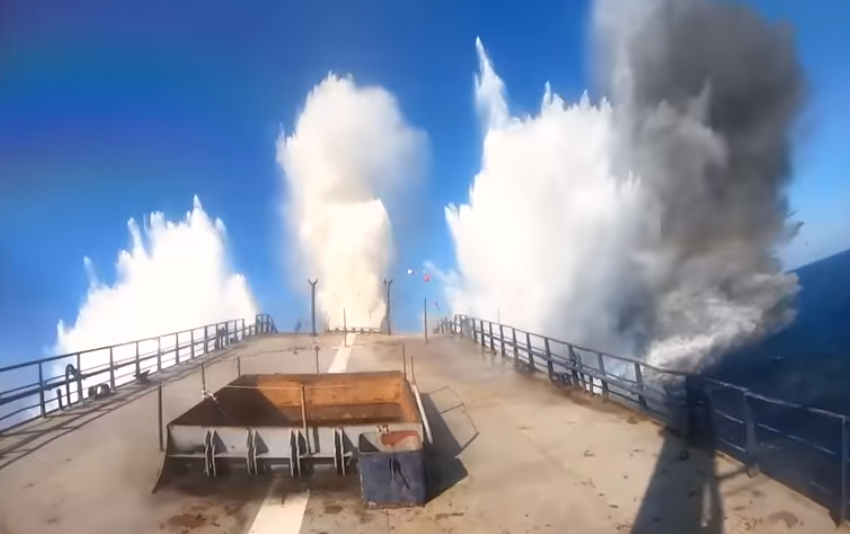Last April, the Air Force released previously classified footage of their devastating new “QUICKSINK” smart bomb successfully sinking a large cargo ship in one clean shot. More recently, the Air Force released new footage of the same incident taken aboard the derelict cargo ship, Courageous as it is struck by QUICKSINK and rapidly sinks to the floor of the Gulf of Mexico.
Dropped by an F-15E Strike Eagle, the cutting-edge munition has earned its name for the ability to effectively sink large enemy vessels much more cheaply and safely than the conventional method of firing a torpedo from a submarine. Developed in a partnership between the U.S. Air Force and the U.S. Navy, the new munition is expected to offer unprecedented versatility against current and emerging threats from Russian and Chinese maritime aggression.
Air Force Research Laboratory Sought Submarine-Like Ability
When the Air Force Research Laboratory (AFRL) set out to design and build QUICKSINK, they had three main goals. First was the ability to mimic the lethality of a heavy, submarine-launched torpedo to sink an enemy vessel with a single shot. Second, and equally as important, they wanted to do this at a fraction of the cost of a conventional torpedo. And third, and most importantly, they wanted to do it with a fighter aircraft as opposed to a submarine, which by its very nature places more personnel at risk in these types of close-up exchanges than a single aircraft.
“Heavy-weight torpedoes are effective [at sinking large ships] but are expensive and employed by a small portion of naval assets,” said Maj. Andrew Swanson, 85th TES division chief of Advanced Programs, on the project’s website. “With QUICKSINK, we have demonstrated a low-cost and more agile solution that has the potential to be employed by the majority of Air Force combat aircraft, providing combatant commanders and warfighters with more options.”
“A Navy submarine has the ability to launch and destroy a ship with a single torpedo at any time, but the QUICKSINK JCTD aims to develop a low-cost method of achieving torpedo-like kills from the air at a much higher rate and over a much larger area,” adds Kirk Herzog, AFRL program manager. “QUICKSINK is unique in that it can provide new capabilities to existing and future DOD weapons systems, giving combatant commanders and our national leaders new ways to defend against maritime threats.”
Quicksink Offers Advanced Targeting Technology, Payload Versatility, & Risk Reduction
As demonstrated, QUICKSINK is actually a customized adaptation of a weapon system already in use, the Joint Direct Attack Munition (JDAM) GBU. According to the Air Force, “The Joint Direct Attack Munition is a guidance tail kit that converts existing unguided free-fall bombs into accurate, adverse weather “smart” munitions.”
This conversion from a “regular bomb” to a “smart bomb” is accomplished by giving an existing JDAM a whole new tail section that includes both an inertial navigation system and a global positioning system (GPS) guidance control unit. Once installed, the new combination navigation system allows mission planners to load target coordinates into the aircraft before takeoff, alter coordinates manually by the aircrew before weapon release, or changed through target designation using onboard aircraft sensors once on site.


According to the Air Force, “in its most accurate mode, the JDAM system will provide a weapon circular error probable of 5 meters or less during free flight when GPS data is available.” Without GPS, the weapon is rated at 30-meter accuracy.
The JDAM also offers payload versatility. This includes a 500-pound warhead version, a 1,000-pound warhead version, and a full-sized 2,000-pound warhead. The customized JDAM Quicksink demonstrated in the video utilized the 2,000-pound warhead for maximum impact.


According to the Air Force, JDAM is currently compatible with B-1B, B-2A, B-52H, AV-8B, F-15E, F/A-18C/D/E/F, F-16C/D, and F-22 aircraft. They also note that “follow-on integration efforts are currently underway or planned to evaluate compatibility with the A-10, F-35 Joint Strike Fighter, and MQ-9 Reaper unmanned aerial vehicle.”
As far as risk reduction, a single F-15E Strike Eagle like the one in the video is a little under $90 million per aircraft, whereas a submarine can cost as much as $2.8 billion. The risk to the crew is also dramatically reduced when using an air-launched platform as opposed to a submarine-launched attack, which effectively reveals their position once firing a torpedo. The Air Force also notes that the custom QUICKSINK JDAM in the video cost around $30,000.
Christopher Plain is a Science Fiction and Fantasy novelist and Head Science Writer at The Debrief. Follow and connect with him on Twitter, learn about his books at plainfiction.com, or email him directly at christopher@thedebrief.org.

